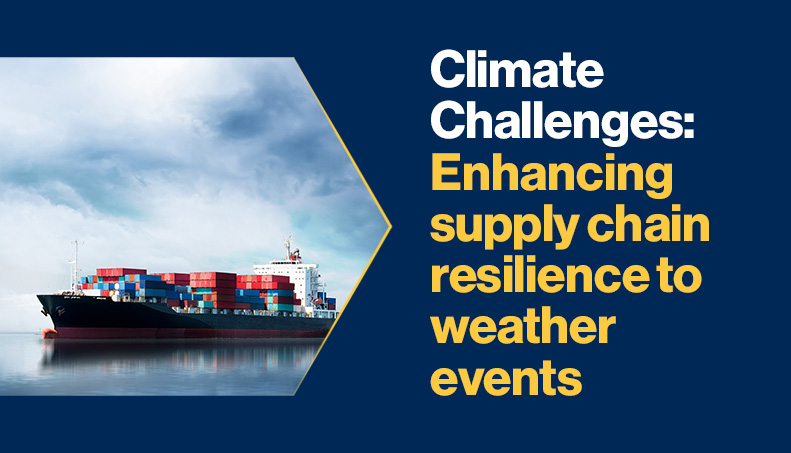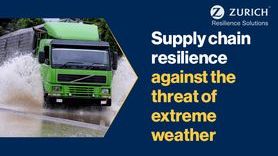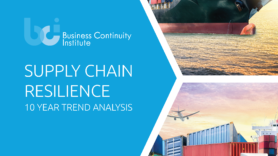Climate Challenges: Enhancing supply chain resilience to weather events

Extreme weather is one of the leading causes of supply chain disruptions worldwide, and with forecasts predicting an increase in both the frequency and severity of such events[1], practitioners must remain alert to the global impact. Proactive plans are essential to mitigate the effects of extreme weather and ensure continuity in supply chains.
Research from the BCI’s Supply Chain Resilience Report 2024, sponsored by Zurich Resilience Solutions, found that almost every organization views climate risk as a looming threat over the next five years, and many think weather-related events and natural disasters could seriously disrupt their operations in the medium term. Recent events have proved these predictions correct. The recent floods experienced in Valencia, Spain during October 2024 has underlined the fact that extreme weather events have the potential to cause mass disruption and practitioners should be prepared.
Extreme floods in Spain
Flooding and landslides devastated eastern and southern Spain in late October, claiming over 200 lives, and causing extensive property and infrastructure damage. With over a year’s worth of rain falling in just eight hours, the region was subjected to intense flooding with very little, if any, notice from the authorities. Although heavy rainfall is common in this region, this was an extreme event. Spain’s State Meteorological Agency reported that the region experienced a historic storm, the worst of the 21st century and more severe than any storm since 1987.
As a result of the flooding, overhead motorway lines collapsed, affecting long distance traffic to the extent that the regional government banned heavy vehicles not destined for the area. Extensive damage to railway tracks and lines, including the high-speed service, closed rail travel, and ports temporarily closed.
This region of Spain is home to significant warehouse and distribution centres including the automotive and manufacturing industries. It also forms part of Spain’s agricultural heartland. As a result, suppliers believe the short and long-term impacts, timed with peak shipping periods, will pose significant challenges and create adverse effects for those reliant on goods movement across Europe[2]. While the full impact isn’t yet known, road repairs, building restorations, and lost productivity is significant not only for Spain, but also organizations with supply lines in the region.[3]
This year’s research shows that the main consequence of disruption for surveyed organizations is a loss of productivity with almost 80% of organizations affected this way. Service disruption was reported as the second top consequence by 75.4% of respondents, followed by customer complaints (70.1%).
Climate events highlight the importance of supply chain mapping
Extreme climate events have the potential to create significant global impacts, so it is encouraging that this year’s research indicates organizations are placing greater emphasis on scrutinising their entire supply chains to identify the origins of disruptions, including climate-related causes. This more comprehensive approach has revealed that the primary source of disruptions for most organizations lies within the first two tiers of their supply chain, with extreme weather events being one of the leading causes of disruption. 26.6% of organizations experienced adverse weather and natural disaster effects on their supply chain over the past twelve months. However, despite this, 36.7% of respondents do not currently analyse climate risks. Fortunately, the majority of those plan to do so in the future, demonstrating a growing awareness of the impact of climate change on supply chains and the pressing need to implement preventive measures. To emphasise, this analysis must happen in the multi-tier supply chain to ensure its effectiveness in building resilience, hence the importance of mapping.
Regional differences
Currently, awareness of supply chain risks differs greatly by region. In Europe, nearly half of organizations have yet to factor climate risk into their supply chain considerations, though a quarter intend to tackle this issue. Asia demonstrates a higher level of awareness, likely due to the more frequent occurrence of weather-related events and natural disasters in the region. Due to the shifting nature of climate risks, practitioners with supply chain lines in regions where weather related disruption is less common should seek to create contingency plans where they don’t currently exist, in order to tackle the growing global threats.
What practitioners can do to protect their supply chain against climate risk
Analysing the impact of weather-related events and natural disasters on the supply chain is essential. Organizations must develop strategies to maintain continuity during and after disruptive climate events. This cannot be done without having full chain visibility. These strategies can include identifying and diversifying suppliers, optimising inventory levels, and improving communication with critical partners. By taking a proactive approach, organizations can minimise their potential losses, operational downtimes, and protect the organization's reputation.
To increase supply chain visibility, organizations can start by using mapping tools to identify key suppliers and their locations. Then, they can apply climate modelling tools to these locations to understand the potential climate risks to their supply chains. Organizations that lack resources for mapping tools can strengthen relationships with suppliers to identify challenges and issues. They can also leverage their insurers’ risk assessments to pinpoint threats to supply chains and regional climate risks. This year’s research indicates that more insurers are seeing insurance as a two-way process, rather than an adverse event equals payout scenario.
Once visibility and modelling are established, practitioners can inform stakeholders within their organization to raise awareness and develop mitigation, adaptation, and contingency plans to manage potential risks, exposures, or vulnerabilities.
Supply Chain Resilience Report - Key climate takeaways
Organizations are increasingly focused on the impact of weather-related events and natural disasters on their supply chains, acknowledging concerns to varying extents depending on the region. This shift highlights a growing awareness of the significant impact climate-related events can have on supply chains. However, with threats on the rise, and in more extreme forms, practitioners should maintain a strong focus on this area, highlighting it as a primary concern to top management. They should take steps, such as those mentioned above, to enhance supply chain visibility, identify climate threats to the regions they operate in, and develop mitigation plans to address these risks.
The full BCI Supply Chain Resilience Report 2024 examines growing climate-related risks to global supply chains, the impacts, outcomes, and mitigation strategies plus much more. We extend our thanks to Zurich Resilience Solutions for their generous support in sponsoring this research.








































